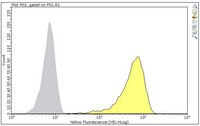MABF2031-25UG Sigma-AldrichAnti-CD1b Antibody, clone BCD1b3.1
Anti-CD1b, clone BCD1b3.1, Cat. No. MABF2031, is a mouse monoclonal antibody that detects T-cell surface glycoprotein CD1b and it has been tested for use in Flow Cytometry, Immunohistochemistry, Immunoprecipitation, Inhibition assays, and Neutralizing function.
More>> Anti-CD1b, clone BCD1b3.1, Cat. No. MABF2031, is a mouse monoclonal antibody that detects T-cell surface glycoprotein CD1b and it has been tested for use in Flow Cytometry, Immunohistochemistry, Immunoprecipitation, Inhibition assays, and Neutralizing function. Less<<Produits recommandés
Aperçu
| Replacement Information |
|---|
Tableau de caractéristiques principal
| Species Reactivity | Key Applications | Host | Format | Antibody Type |
|---|---|---|---|---|
| H, Gp | FC, IHC, IP, Inhibition, NEUT | M | Purified | Monoclonal Antibody |
| References |
|---|
| Product Information | |
|---|---|
| Format | Purified |
| Presentation | Purified mouse monoclonal antibody IgG1 in PBS without azide. |
| Physicochemical Information |
|---|
| Dimensions |
|---|
| Materials Information |
|---|
| Toxicological Information |
|---|
| Safety Information according to GHS |
|---|
| Safety Information |
|---|
| Packaging Information | |
|---|---|
| Material Size | 25 μg |
| Transport Information |
|---|
| Supplemental Information |
|---|
| Specifications |
|---|
| Global Trade Item Number | |
|---|---|
| Référence | GTIN |
| MABF2031-25UG | 04054839476884 |
Documentation
Anti-CD1b Antibody, clone BCD1b3.1 Certificats d'analyse
| Titre | Numéro de lot |
|---|---|
| Anti-CD1b, clone BCD1b3.1 Monoclonal Antibody | Q3026361 |









[271498-ALL].jpg)


